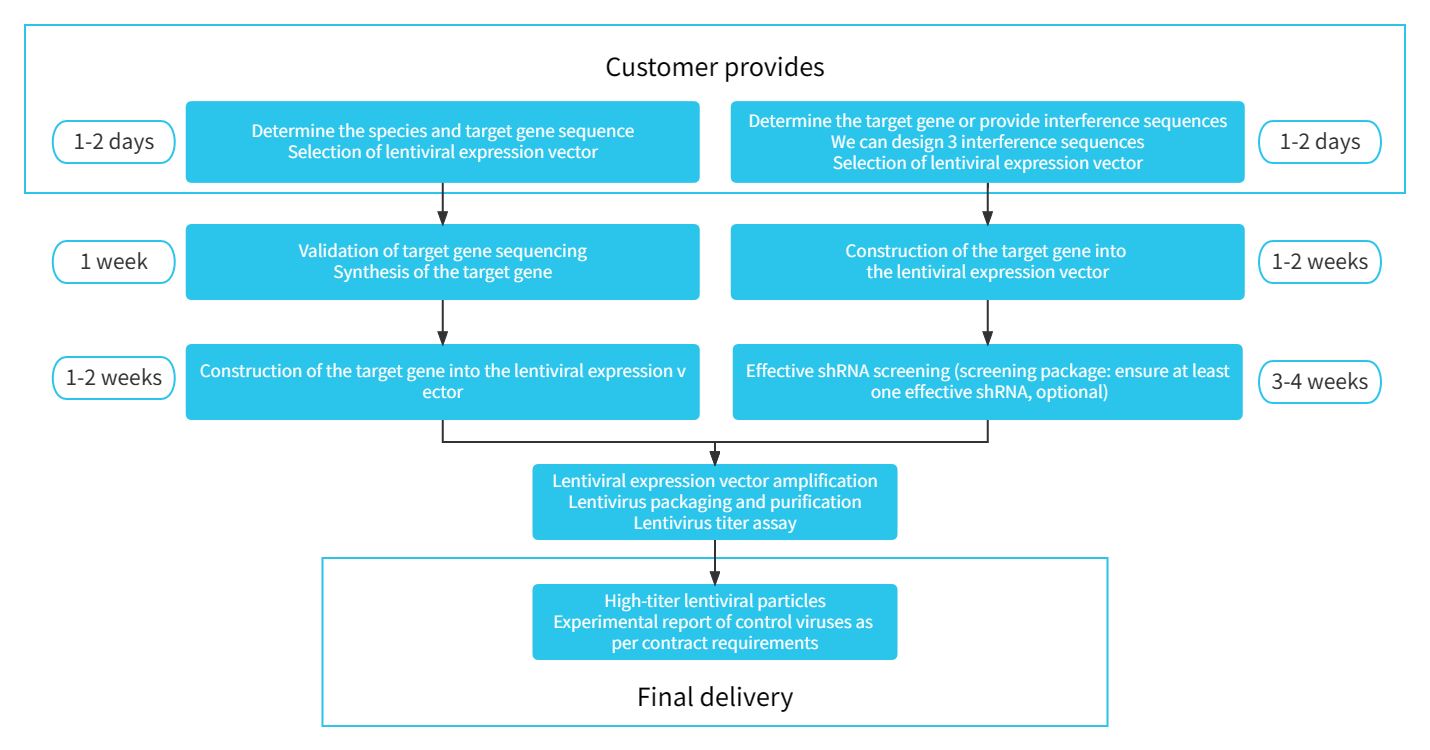Lentiviral vectors (LVs) are viral vector systems derived from human immunodeficiency virus (HIV-1) and modified to efficiently deliver target genes (or RNAi) into primary cells or cell lines of both animals and humans. These vectors have the ability to infect both dividing and non-dividing cells. The lentiviral vector genome is a single-stranded positive-sense RNA. Upon entry into the cell, the genome undergoes reverse transcription into DNA in the cytoplasm through the reverse transcriptase it carries, forming a DNA pre-integration complex. After entering the cell nucleus, the DNA integrates into the cellular genome. The integrated DNA is then transcribed into mRNA, which returns to the cytoplasm to express the target gene or fragment.
The lentiviral vector mediates stable and persistent gene expression or RNA interference (RNAi) by integrating the target gene into the host cell genome. It replicates along with the division of the cellular genome. Additionally, the lentiviral vector can effectively infect and integrate into non-dividing cells. These characteristics distinguish the lentiviral vector from other viral vectors, such as non-integrating adenoviral vectors, low-integration rate adeno-associated viral vectors, and conventional retroviral vectors that integrate only into dividing cells. Abundant literature studies indicate that the tissues or cells with long-term expression mediated by the lentiviral vector include the brain, liver, muscles, retina, hematopoietic stem cells, bone marrow mesenchymal stem cells, macrophages, etc.
The lentiviral expression vector deletes most of the genes of the HIV virus and only retains the LTR sequence, packaging signal, and Rev response element, etc. Therefore, it has low immunogenicity, resulting in minimal cellular immune response at the injection site and a relatively low humoral immune response, which does not affect the second injection of the viral vector.
The lentiviral packaging system primarily consists of lentiviral expression vectors, packaging vectors, and envelope vectors. Generally, it comprises three plasmids (second-generation system) or four plasmids (third-generation system). The cells used for packaging the virus are typically from the 293 cell line series. The main process involves co-transfecting 293 cells with plasmids that make up the lentiviral system. After 48-72 hours, the cell culture supernatant is collected, and the lentiviral particles are obtained after concentration and purification.
BrainVTA’s lentiviral vector is based on the internationally recognized third-generation vector system and it has been modified and structured to form a four-plasmid system through certain modifications. The transfer vector contains the lentiviral backbone with the target gene and all cis-acting elements necessary for packaging the corresponding genomic RNA. It allows for the stable or conditionally inducible expression of the transferred gene or shRNA, either individually or in combination. In addition, three auxiliary plasmids are used to provide the trans-acting factors required for virus packaging. The system also incorporates a “self-inactivation” modification to prevent self-replication and transfer of progeny viruses, ensuring that the generated lentivirus possesses excellent biosafety.
● Infection works on both dividing and non-dividing cells.
● Easy to operate with high safety.
● Stable and efficient expression.
● Short experimental cycle.
● Multiple vector options available.
● Transferring target genes/RNAi genes into difficult-to-transfect cells, such as neurons, stem cells, or other primary cells.
● Transferring target genes/RNAi genes into animal tissues for long-term expression.
● Constructing cell lines that stably express the target protein/RNAi and then using ex vivo methods to introduce them into animals.
● Gene therapy.
● Transgenic animals.
● Gene knockout.
● Drug research: Constructing cell lines that express receptor proteins to study drug effects.
● Rapid establishment of cell lines for producing the target protein, a promising eukaryotic cell expression method.

In-stock LV product lists: https://www.brainvta.ltd/index/goods/detail.html?cid=358
More LV application cases: https://www.brainvta.ltd/index/goods/jsdetail.html?cid=219

US: 3675 Market Street, Suite 200, Philadelphia, PA19104 Tel: +1 (215) 205-6963 | +086 027-65023363
E-mail: hui.wang@genevoyager.com
China: No128, Guanggu 7th Rd, East Lake High-tech Development Zone, Wuhan, China Tel: 17720522078
E-mail: marketing@genevoyager.com